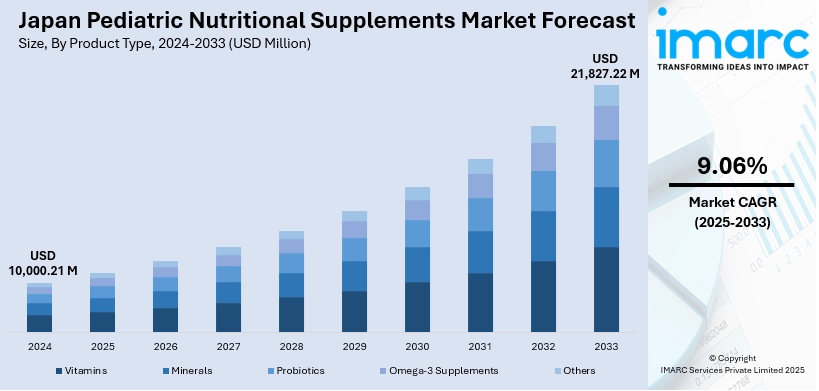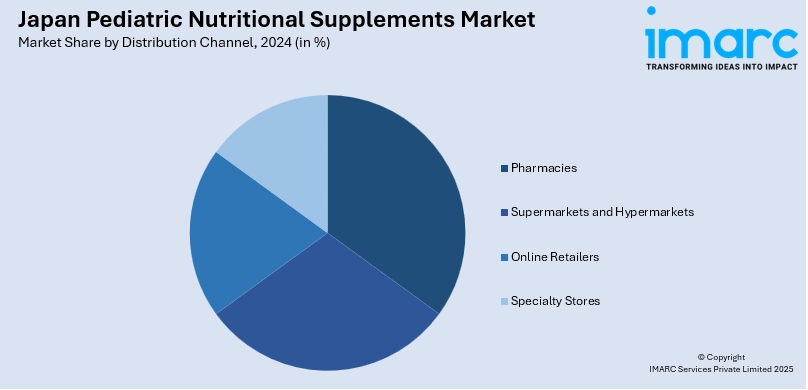
Japan Pediatric Nutritional Supplements Market Size, Share, Trends and Forecast by Product Type, Formulation, Age Group, Distribution Channel, and Region, 2025-2033
Japan Pediatric Nutritional Supplements Market Overview:
The Japan pediatric nutritional supplements market size reached USD 10,000.21 Million in 2024. Looking forward, IMARC Group expects the market to reach USD 21,827.22 Million by 2033, exhibiting a growth rate (CAGR) of 9.06% during 2025-2033. The market is evolving rapidly, driven by growing awareness about child health, rising parental focus on immunity and development, and innovations in product formulations. The market is also influenced by lifestyle changes and increasing demand for convenient, health-boosting options. Key players are expanding their offerings to meet diverse needs within the Japan pediatric nutritional supplements market share.
|
Report Attribute
|
Key Statistics
|
|---|---|
|
Base Year
|
2024
|
|
Forecast Years
|
2025-2033
|
|
Historical Years
|
2019-2024
|
| Market Size in 2024 | USD 10,000.21 Million |
| Market Forecast in 2033 | USD 21,827.22 Million |
| Market Growth Rate 2025-2033 | 9.06% |
Japan Pediatric Nutritional Supplements Market Trends:
Rising Health Awareness Among Parents
Japanese parents are increasingly prioritizing their children's health, driven by heightened awareness regarding nutrition's role in early development. This shift is influenced by widespread access to health information, government-led health campaigns, and a cultural emphasis on preventive care. Parents are more proactive in seeking supplements that support immunity, brain development, and overall growth. In urban areas, parents find it harder to give their families healthy meals due to their demanding schedules. Therefore, many individuals see nutritional supplements as a simple and dependable option for missing nutrients. The increased knowledge is increasing sales and inspiring producers to create formulas that are free of allergens, clean, and made for various age groups.

To get more information on this market, Request Sample
Aging Population and Smaller Family Sizes
Japan’s demographic landscape, marked by an aging population and declining birth rates, is reshaping consumer behavior. With fewer children per household, parents and grandparents are more willing to invest in premium health products for the younger generation. This dynamic leads to increased spending per child, especially on products perceived to enhance long-term well-being. Additionally, older caregivers often bring traditional health beliefs into purchasing decisions, favoring supplements that align with both modern science and cultural practices. The focus on quality over quantity in child-rearing has made pediatric nutrition a priority, driving demand for supplements that support immunity, cognitive development, and digestive health. This demographic shift is a key factor sustaining Japan pediatric nutritional supplements market growth despite a shrinking youth population.
Innovation in Product Formats and Ingredients
The Japanese market is highly receptive to innovation, and this is evident in the pediatric supplements sector. Companies are introducing child-friendly formats such as gummies, dissolvable powders, and flavored liquids to improve compliance and appeal. These innovations are often backed by research and tailored to specific developmental stages, making them more attractive to health-conscious parents. Additionally, there is a growing demand for natural, plant-based, and functional ingredients like probiotics, DHA, and vitamins derived from whole foods. Clean-label trends and transparency in sourcing are also influencing purchasing decisions. This wave of innovation not only differentiates brands but also expands the market by making supplements more accessible and enjoyable for children, thereby encouraging consistent use.
Japan Pediatric Nutritional Supplements Market Segmentation:
IMARC Group provides an analysis of the key trends in each segment of the market, along with forecasts at the country and regional levels for 2025-2033. Our report has categorized the market based on product type, formulation, age group, and distribution channel.
Product Type Insights:
- Vitamins
- Minerals
- Probiotics
- Omega-3 Supplements
- Others
The report has provided a detailed breakup and analysis of the market based on the product type. This includes vitamins, minerals, probiotics, omega-3 supplements, and others.
Formulation Insights:
- Tablets
- Capsules
- Powders
- Liquids
- Gummies
A detailed breakup and analysis of the market based on the formulation have also been provided in the report. This includes tablets, capsules, powders, liquids, and gummies.
Age Group Insights:
- Infants (0-2 years)
- Children (3-12 years)
- Adolescents (13-18 years)
A detailed breakup and analysis of the market based on the age group have also been provided in the report. This includes infants (0-2 years), children (3-12 years), and adolescents (13-18 years).
Distribution Channel Insights:

- Pharmacies
- Supermarkets and Hypermarkets
- Online Retailers
- Specialty Stores
A detailed breakup and analysis of the market based on the distribution channel have also been provided in the report. This includes pharmacies, supermarkets and hypermarkets, online retailers, and specialty stores.
Regional Insights:
- Kanto Region
- Kansai/Kinki Region
- Central/ Chubu Region
- Kyushu-Okinawa Region
- Tohoku Region
- Chugoku Region
- Hokkaido Region
- Shikoku Region
The report has also provided a comprehensive analysis of all the major regional markets, which include the Kanto Region, Kansai/Kinki Region, Central/ Chubu Region, Kyushu-Okinawa Region, Tohoku Region, Chugoku Region, Hokkaido Region, and Shikoku Region.
Competitive Landscape:
The market research report has also provided a comprehensive analysis of the competitive landscape. Competitive analysis such as market structure, key player positioning, top winning strategies, competitive dashboard, and company evaluation quadrant has been covered in the report. Also, detailed profiles of all major companies have been provided.
Japan Pediatric Nutritional Supplements Market Report Coverage:
| Report Features | Details |
|---|---|
| Base Year of the Analysis | 2024 |
| Historical Period | 2019-2024 |
| Forecast Period | 2025-2033 |
| Units | Million USD |
| Scope of the Report |
Exploration of Historical Trends and Market Outlook, Industry Catalysts and Challenges, Segment-Wise Historical and Future Market Assessment:
|
| Product Types Covered | Vitamins, Minerals, Probiotics, Omega-3 Supplements, Others |
| Formulations Covered | Tablets, Capsules, Powders, Liquids, Gummies |
| Age Groups Covered | Infants (0-2 years), Children (3-12 years), Adolescents (13-18 years) |
| Distribution Channels Covered | Pharmacies, Supermarkets and Hypermarkets, Online Retailers, Specialty Stores |
| Regions Covered | Kanto Region, Kansai/Kinki Region, Central/ Chubu Region, Kyushu-Okinawa Region, Tohoku Region, Chugoku Region, Hokkaido Region, Shikoku Region |
| Customization Scope | 10% Free Customization |
| Post-Sale Analyst Support | 10-12 Weeks |
| Delivery Format | PDF and Excel through Email (We can also provide the editable version of the report in PPT/Word format on special request) |
Key Questions Answered in This Report:
- How has the Japan pediatric nutritional supplements market performed so far and how will it perform in the coming years?
- What is the breakup of the Japan pediatric nutritional supplements market on the basis of product type?
- What is the breakup of the Japan pediatric nutritional supplements market on the basis of formulation?
- What is the breakup of the Japan pediatric nutritional supplements market on the basis of age group?
- What is the breakup of the Japan pediatric nutritional supplements market on the basis of distribution channel?
- What is the breakup of the Japan pediatric nutritional supplements market on the basis of region?
- What are the various stages in the value chain of the Japan pediatric nutritional supplements market?
- What are the key driving factors and challenges in the Japan pediatric nutritional supplements market?
- What is the structure of the Japan pediatric nutritional supplements market and who are the key players?
- What is the degree of competition in the Japan pediatric nutritional supplements market?
Key Benefits for Stakeholders:
- IMARC’s industry report offers a comprehensive quantitative analysis of various market segments, historical and current market trends, market forecasts, and dynamics of the Japan pediatric nutritional supplements market from 2019-2033.
- The research report provides the latest information on the market drivers, challenges, and opportunities in the Japan pediatric nutritional supplements market.
- Porter's five forces analysis assist stakeholders in assessing the impact of new entrants, competitive rivalry, supplier power, buyer power, and the threat of substitution. It helps stakeholders to analyze the level of competition within the Japan pediatric nutritional supplements industry and its attractiveness.
- Competitive landscape allows stakeholders to understand their competitive environment and provides an insight into the current positions of key players in the market.
Need more help?
- Speak to our experienced analysts for insights on the current market scenarios.
- Include additional segments and countries to customize the report as per your requirement.
- Gain an unparalleled competitive advantage in your domain by understanding how to utilize the report and positively impacting your operations and revenue.
- For further assistance, please connect with our analysts.
 Request Customization
Request Customization
 Speak to an Analyst
Speak to an Analyst
 Request Brochure
Request Brochure
 Inquire Before Buying
Inquire Before Buying




.webp)




.webp)












